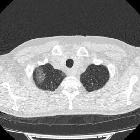chronic eosinophilic pneumonia





Chronic eosinophilic pneumonia (CEP) is an idiopathic condition characterized by the alveoli filling with an inflammatory, eosinophil-rich infiltrate. Classically on imaging, it appears as chronic consolidation with upper zone and peripheral predominance.
Epidemiology
Most patients are middle aged, and approximately 50% have background asthma. There is a greater female predilection .
Clinical presentation
It is often insidious with symptoms averaging several months before diagnosis.
The diagnosis is usually based on the association of:
- respiratory symptoms of usually more than 2 weeks duration
- alveolar and/or blood eosinophilia (alveolar eosinophilia ≥40% of bronchoalveolar lavage (BAL) differential cell count; blood eosinophilia ≥1000/mm)
- pulmonary infiltrates with usually a peripheral predominance on chest imaging
- exclusion of any known cause of eosinophilic lung disease
Pathology
Histology typically shows accumulation of eosinophils and lymphocytes in the alveoli and interstitium, with interstitial fibrosis. An organizing pneumonia pattern or an eosinophilic abscess may also be seen. Lung function tests can be normal in mild cases but usually show restrictive defects. Peripheral blood eosinophilia is usually mild or moderate but occasionally can be severe.
Markers
- increased serum IgE levels can be seen in two-thirds of patients
- the erythrocyte sedimentation rate (ESR) is usually elevated
- peripheral blood thrombocytosis has also been reported
- the percentage of eosinophils in the BAL fluid is very high
Radiographic features
Plain radiograph
There is non-segmental peripheral airspace consolidation (“photographic negative shadow of pulmonary edema” - see reverse bat wing appearance) involving mainly the upper lobes but may only be seen in less than half of cases.
CT
CT demonstrates typical non-segmental areas of airspace consolidation with peripheral predominance. There may be a middle or upper zone predilection .
Less common findings predominate in later stages of disease and includes
Later imaging, e.g. 2 months after the onset of symptoms, may also show linear band-like opacities parallel to the pleural surface or lobar atelectasis . This vertical band is not interrupted by the pulmonary fissures.
In <10% of cases, a pleural effusion may be observed.
Treatment and prognosis
The long-term prognosis is considered excellent but the majority often will require long-term low-dose oral corticosteroid therapy in order to prevent relapse .
History and etymology
It was first described by C B Carrington et al in 1969 .
Differential diagnosis
For CT imaging appearances, consider
- eosinophilic granulomatosis with polyangiitis (EGPA) (previously known as Churg-Strauss syndrome)
- cryptogenic organizing pneumonia (to be considered with an appearance of linear band-like opacities parallel to the pleural surface, the changes though have a basal predilection)
Siehe auch:
und weiter:

 Assoziationen und Differentialdiagnosen zu chronic eosinophilic pneumonia:
Assoziationen und Differentialdiagnosen zu chronic eosinophilic pneumonia:

